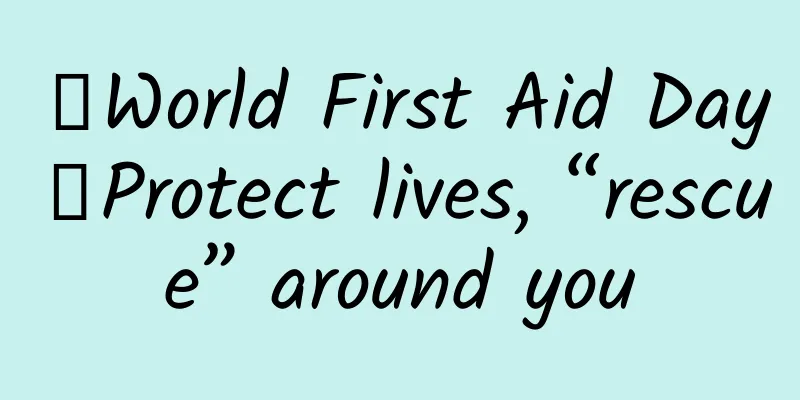【World First Aid Day】Protect lives, “rescue” around you

|
Author: Wang Changyuan, Chief Physician, Xuanwu Hospital, Capital Medical University Reviewer: He Jingyu, Chief Physician, Xuanwu Hospital, Capital Medical University In life, people may suffer from cardiac arrest due to illness, car accidents, electric shock, etc. If rescue is not timely, they will lose their lives. There are about 550,000 sudden cardiac deaths in my country every year, an average of 1,500 people die from cardiac arrest every day, and one person suffers from cardiac arrest every minute. 87% of these cardiac arrests occur outside the hospital, and there are no professional emergency personnel nearby, so the rescue success rate is less than 1%. At the scene of cardiac arrest, family members, companions, passers-by and other bystanders should perform effective cardiopulmonary resuscitation on the patient as soon as possible, which is a key measure to save lives. It is very important to effectively perform cardiopulmonary resuscitation within the first 4 to 6 minutes of cardiac arrest. The survival rate will decrease by 10% for every 1 minute of delay. If cardiopulmonary resuscitation is not performed for more than 10 minutes, the patient will almost 100% die. If bystanders have not received training in first aid skills such as cardiopulmonary resuscitation, and cannot perform cardiopulmonary resuscitation on cardiac arrest patients in a timely and effective manner, and wait for professional medical personnel to arrive at the scene before starting first aid, the patient will almost 100% die. Therefore, only by mastering cardiopulmonary resuscitation skills can the lives of patients with cardiac arrest be saved. Guard life, "rescue" is by your side. Figure 1 Copyright image, no permission to reprint 1. Symptoms of cardiac arrest Cardiac arrest often occurs suddenly, with the patient suddenly losing consciousness, falling to the ground and not responding, with brief limb twitching, intermittent breathing, sighing, and then stopping, pulse cannot be felt, pupils dilated, and face cyanosis. Most cases have no obvious precursor symptoms. 2. Cardiopulmonary resuscitation process Cardiopulmonary resuscitation is a key rescue measure for patients with cardiac arrest. For the general public, it mainly includes assessing the environment, judging consciousness, activating the emergency system, judging pulse and breathing, chest compression, artificial ventilation and electric defibrillation, etc. The specific operations are as follows. 1. Assess the environment: If you find someone lying on the ground, you should first determine whether the environment is safe. If it is a car accident, fire scene, etc., which may cause harm to the patient and rescuers, it is not suitable to perform cardiopulmonary resuscitation. The patient should be transferred to a safe place for rescue. 2. Assess the patient's consciousness: Pat the patient's shoulders with both hands and shout in the patient's ears: "What's wrong with you? Are you okay?" If there is no response, it is assumed that the patient has lost consciousness. 3. Activate the emergency rescue system: Regardless of whether or not there is cardiac arrest, you should immediately activate the emergency rescue system to call for help. Call 120 emergency number yourself or ask others to do so. Inform the 120 dispatcher of the incident, location, contact person, contact number, and other information, and follow the dispatcher's instructions. 4. Determine the pulse and breathing: After calling for help, immediately determine the patient's pulse and breathing, move the patient to a hard and flat surface, unbutton the patient's shirt, touch the carotid artery on the same side, and observe the rise and fall of the chest at the same time for 5 to 10 seconds. If the carotid artery pulse is not touched, the chest does not rise and fall, or there is no sighing breathing, the patient is considered to be in cardiac arrest. 5. Chest compression: The rescuer kneels beside the patient, leans forward, stretches his arms, folds his hands, and presses vertically downward with force and rhythmically. The compression position is the midpoint of the line connecting the patient's two nipples. The compression depth for adults is greater than or equal to 5 cm, and the compression frequency is 100 to 120 times per minute. Continue to press for 30 times and then perform artificial respiration. Figure 2 Copyright image, no permission to reprint 6. Artificial respiration: The rescuer places one hand on the patient's forehead, presses down, and the other hand on the patient's lower jaw, lifts it up slightly, and uses fingers to remove foreign objects in the patient's mouth. Pinch the patient's nose, cover the patient's mouth with your mouth and blow air into the patient, and the blowing time should be more than 1 second. After performing 2 artificial respirations, give 30 chest compressions again, 5 cycles (2 artificial respirations after 30 compressions count as 1 cycle) or after 2 minutes, reassess the patient's pulse and breathing, and change people to perform chest compressions to avoid fatigue that affects the effectiveness of cardiopulmonary resuscitation. If there is an automatic external defibrillator (AED) on site, you should actively look for it. AED is relatively simple to use. Just turn it on and follow the voice prompts. When professionals arrive to perform rescue, bystanders can stop cardiopulmonary resuscitation and hand it over to the professional team for rescue. Figure 3 Copyright image, no permission to reprint In short, it is very important to master the skills of CPR. Timely and effective CPR can save the life of a person who has suffered a cardiac arrest. Protect your health, protect your life, and “rescue” is at your side. References [1] Merchant RM,Topjian AA, Panchal AR,et al. Part 1: Executive Summary: 2020 American Heart Association Guidelines for Cardiopulmonary Resuscitation and Emergency Cardiovascular Care[J]. Circulation,2020,142(16 suppl 2):S337-S357. |
<<: Artificial intelligence is "entering" the legal profession, will it replace lawyers and judges?
>>: You say the earth is round, where is the evidence?
Recommend
Do you know how hard your belly works to avoid bursting?
We all know that our skin (epidermis) is stretcha...
Is there still a chance as big players are crossing over to make mobile phones?
In today's mobile phone industry, Xiaomi can ...
I spent 100,000 yuan in tuition to buy these 12 PPTs!
Good evening! So many friends came at once (nearl...
I have seen 1,000 marketing promotion cases, why are they all ineffective?
In the circle of friends and subscription list of...
Popular Science on Antibacterial and Anti-mildew | If you have a leather sofa at home, be careful of mold!
Many friends choose stylish and comfortable leath...
Event Planning丨How to design a bargaining function?
The bargaining function takes advantage of human ...
How do content products operate?
How do you explain that product and operation are...
World Day to Combat Desertification and Drought丨To combat desertification, please start with these little things
June 17 World Day to Combat Desertification and D...
How to make money by transferring knowledge: Learn these skills and easily earn 10,000+ per month
Payment for knowledge has always existed offline,...
Lin Yu_Course Creation Methodology Baidu Cloud Download
Lin Yu_Course Creation Methodology Lin Yu Course ...
Mobile QQ 8.2.8 update: Image text extraction is easier
[[316739]] Today, Tencent QQ Android and iPhone m...
It's not just about launching a new LOGO. Why is Alibaba Cloud trying so hard to accelerate its internationalization?
A few years ago, an analyst predicted that "...
Why do you always want to eat? You may be controlled by your gut bacteria!
Have you ever had this experience: you just finis...
Shh! This is the secret of astronauts' weight loss | Tutu Science Fiction
Vocabulary weight scale rocket Gravitational acce...






![[Case] 17 pictures to understand the functional development and analysis of Meituan.com’s campus channel structure!](/upload/images/67cc40aa713ca.webp)


